Chakras
Introduction:
Chakras were first documented in the ancient Hindu text of knowledge, the Vedas. The term Chakra comes from the Sanskrit word meaning “wheel”. Chakras are also described as padmas (lotuses).
When visualising chakras it may be useful to perceive or experience them as spinning vortices of energy spiralling through the body from front to back-like little whirlpools, or their lotus as depicted on the relevant yantra.
When we speak about the position of chakras within the self we enter the realms of subtle anatomy-the pranic sheath or layer. In Sanskrit this layer is called Pranamaya kosha.
Yoga anatomy recognises that the pranamaya kosha has a system of nadis, or energy channels-some 72,000! Nadi means current or flow.
Prana- or life force-circulates throughout these channels, sometimes well, sometimes not so well, sometimes throughout certain channels and not through others.
The channels can become “blocked” or sluggish, which can then be perceived physically or mentally as illness. In a similar way traditional Chinese medicine recognises energy as chi, running through meridians.
Where there is a big convergence of several energy channels, a chakra is created and these, too, can become “blocked” creating an imbalance in physical, mental or emotional health and ultimately spiritual health.
Animals are also recognised to have a also pranic layer or sheath.
There are 3 major nadis within pranamaya kosha:
- Sushumna
- Ida
- Pingala
Sushumna can be perceived as running parallel to the spinal cord, which is an extension of the brain. It is at certain points along Sushumna nadi that the chakras lie.
It is generally recognised that there are 7 major chakras or energy centres, however there are many more than this, which are less well known.
Five of the major chakras relate to both a sense and an element. All have a mantra-a bija-or seed mantra, an animal, a god or goddess, a colour, a lotus flower and a yantra,
A yantra is a geometric, sacred illustration. They are all ways of aiding concentration and focus.
The closest physiological counterpart to chakras is both nerve ganglia and the endocrine system, however this is not exact as chakras and nadis belong to pranamaya kosha whereas nerves and the endocrine system are part of annamaya kosha (the gross or physical sheath)
Over the evolution of time various traditions, even within yoga, will have some variations in their visualisations and representations of energy centres so the following is to be taken as a guide.
The following is the second in a series of 3 blogs about Chakras:
SWADISTHANA (Sva-self, athan-dwelling place)

This chakra is strongly associated with the element of water and therefore closely aligned to the Moon and its influence of tides as well as menstruation and even all the fluids in the body. For example, blood, lymph, semen, saliva and tears.
It can be visualised as level with the pubic bone, within Sushumna nadi.
It is also related to the sense of taste. We use the term “mouth watering” and it is this watery element which produces saliva and makes this possible.
It may be visualised as a crimson lotus flower with 6 petals. Within the lotus is a crescent moon. The animal is a crocodile The deity is Vishnu-the creator, Rakini is the consort. and she controls the body’s blood element.
The chakra is related to the sex organs, kidneys and bladder
Swadishana is said to be the seat of the unconscious mind, storing samskaras ( past life memory traces) and ancestral memories.
Imbalances here are manifested as over indulgence in sense pleasures; addictions and escaping into fantasy worlds; difficulties around forming intimate relationships. Menstruation challenges such as painful; heavy; absent, irregular periods are another indication.
Also, any hardening or drying-out diseases, such as arthritis.
Often, tension in the hips and glutes and the inability to “let go” in these areas may also indicate an imbalance here. Sometimes fear can be locked here as a result of trauma, physical or emotional.
Nurturing one’s own healthy desires; any form of creative expression; the ability to take the rough with the smooth; celebrating one’s own achievements; the ability to both give and receive, recognizing life exhibits both shade and light; going “with the flow” are all positive expressions of Swadisthana chakra.
The following are merely selections or suggestions. There are several other options:
ASANAS
SUPTA BADDHA KONASANA | BADDHA KONASANA | FORWARD FOLDS | PELVIC ROCKS/TILTS
Paschimottanasana: One of the oldest known yogasanas. “A stretch for the West side of the body”- Or, the back of the body-that which faces away from the rising sun (the East side).
Standing forward bend variations:
- Modified with bent knees and tail bone tucked under slightly if there is lumbar spine pain:

- Modified with straight (but not locked) legs with tight hamstrings and stiffness, high BP or heart issues.. A good version to use if there is afternoon”energy slump”:
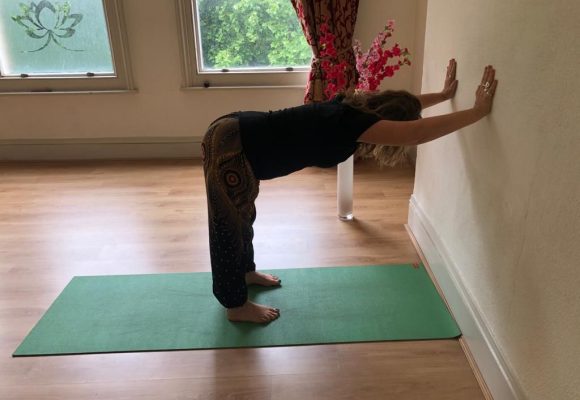
- Slight modification working towards more “stretch” in hamstrings:
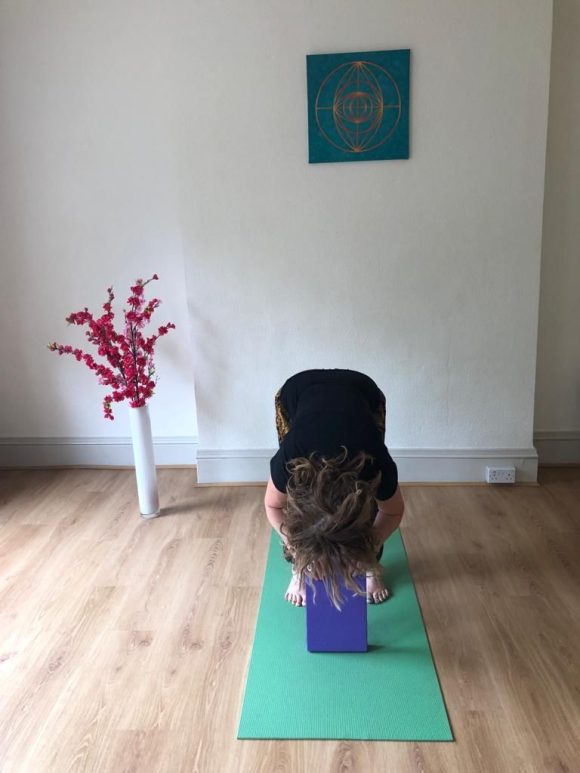
- Full forward bend:
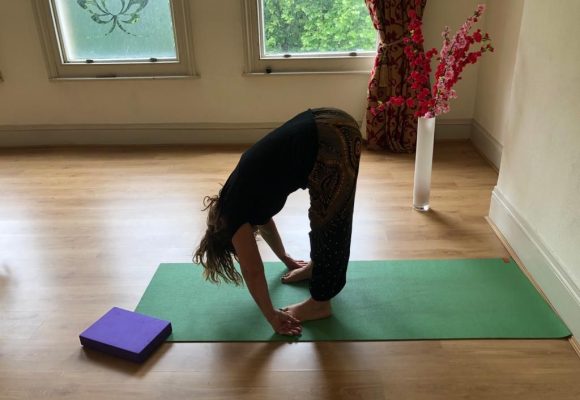
Supta Baddha Konasana
- Extra support under thighs & head so that chin remains level & legs have adequate support:
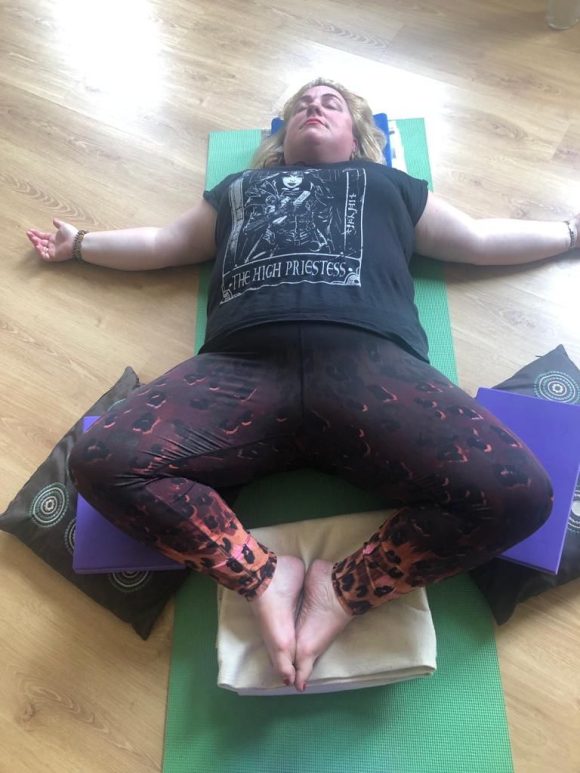
- A little less support required when more flexibility in hips:
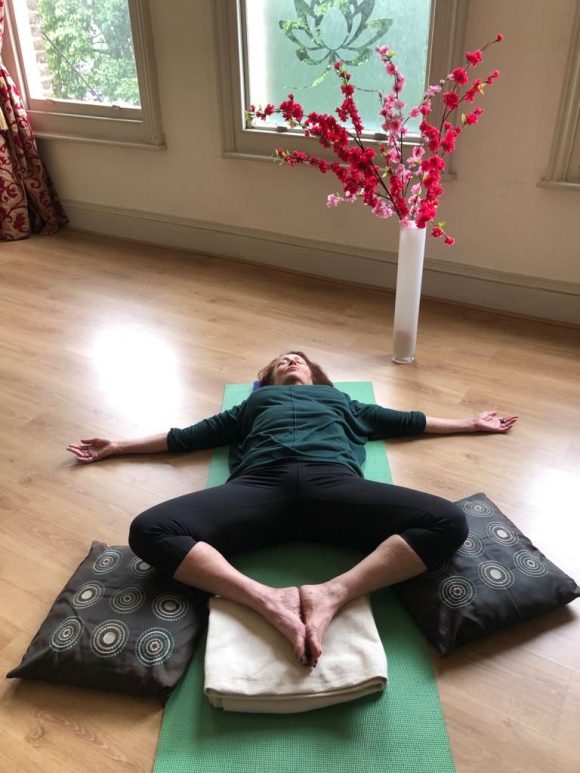
- Variation with more elevation for knees and feet, especially with reproductive health issues:

- Variation to enable feet to be together without effort. Support in a different way and sealing in energy:
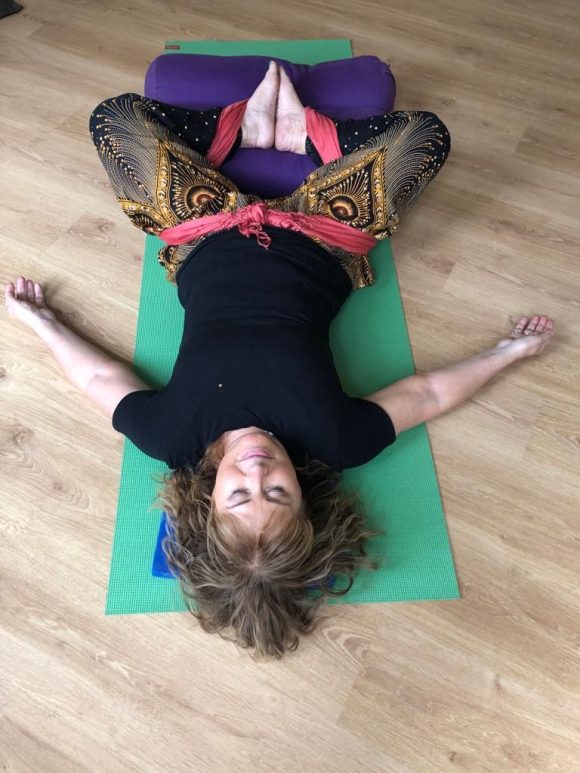
MUDRA
Ushas mudra. Hands clasped. Woman – place right thumb between left thumb & index finger. Men – right thumb lies above the left.
Swadisthana chakra is our centre of both sexuality & creativity. This mudra helps direct sexual energy towards anahata chakra; harmonises the endocrine system and enhances mental alertness.
MANTRA
Vam (Vaaam). Can be repeated aloud, in a whisper or mentally, with awareness at Swadisthana chakra.
VISUALISATIONS
In an upright seated position or lying in Savasana visualize a 6 petalled crimson lotus flower with 6 petals, located behind the pubic bone and in front of the spine, which open on each inhale and close on each exhale.
Or
Visualise waves on the ocean under the light of the full moon.

